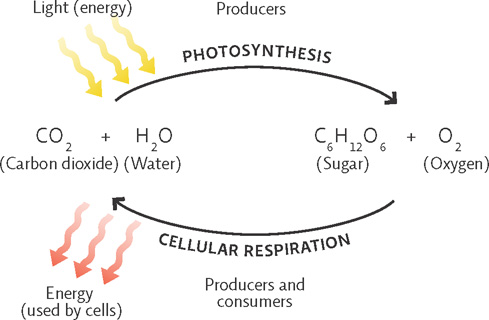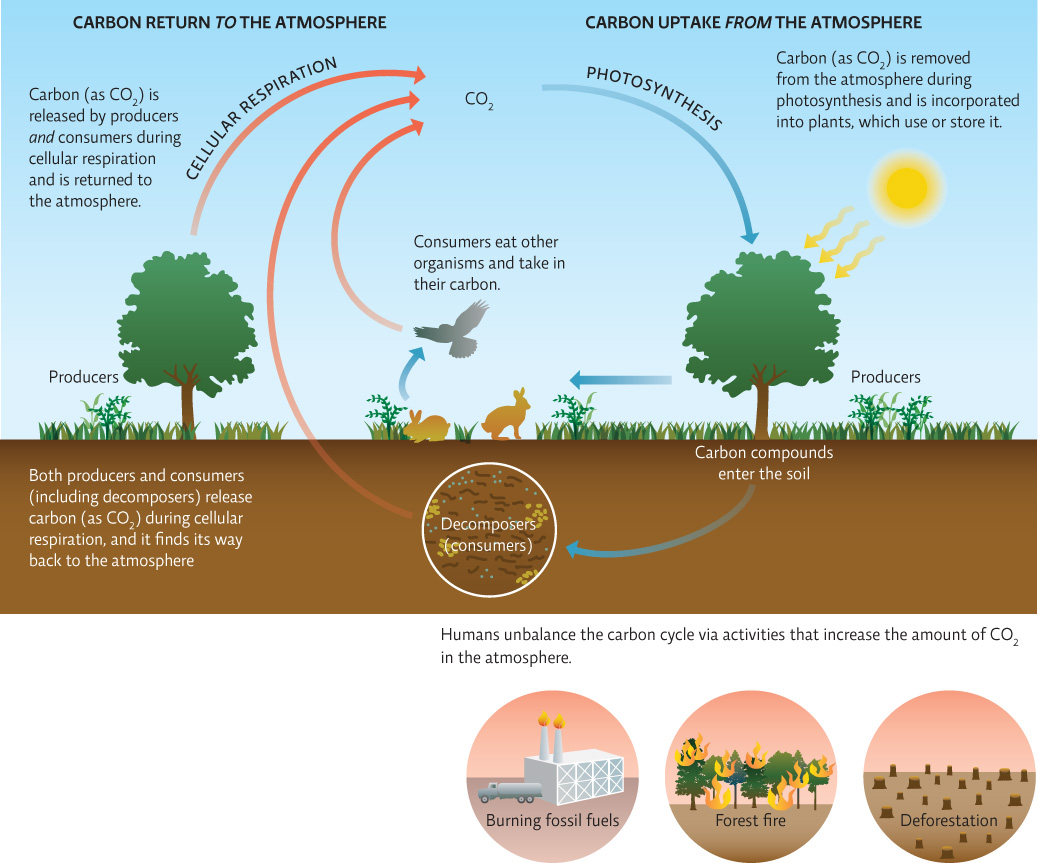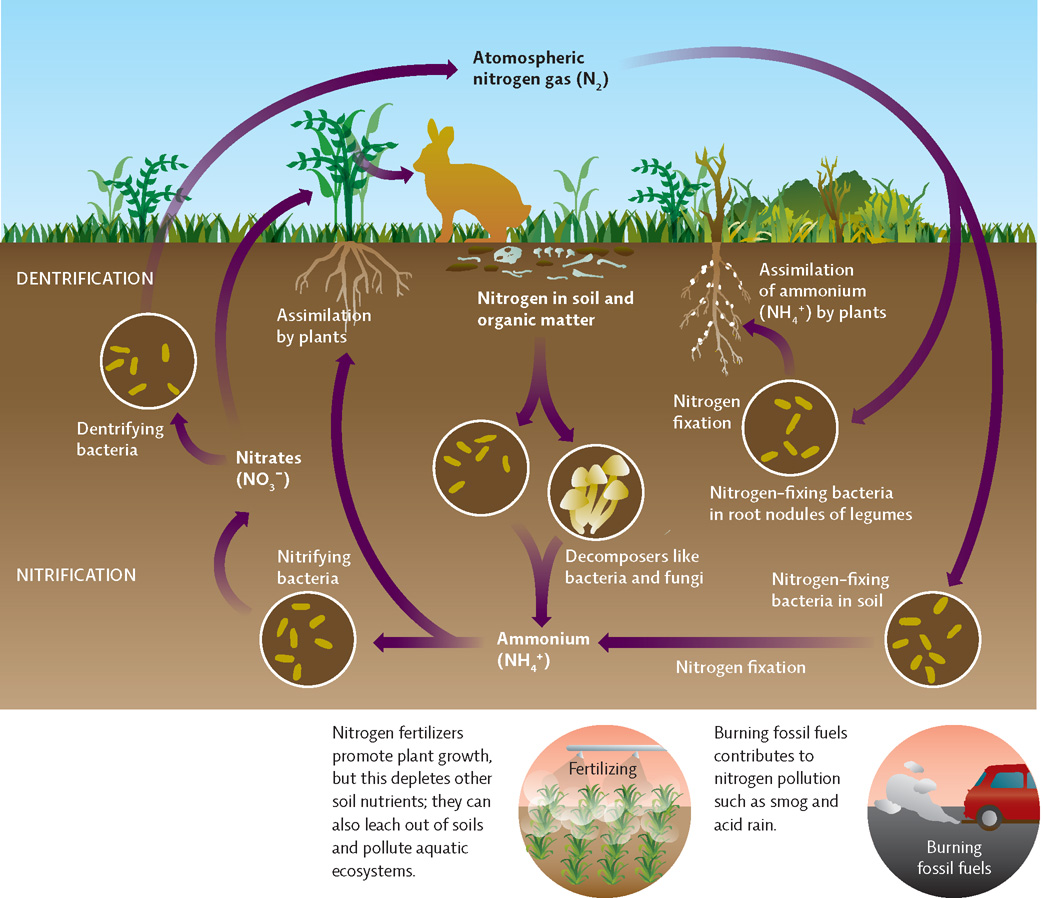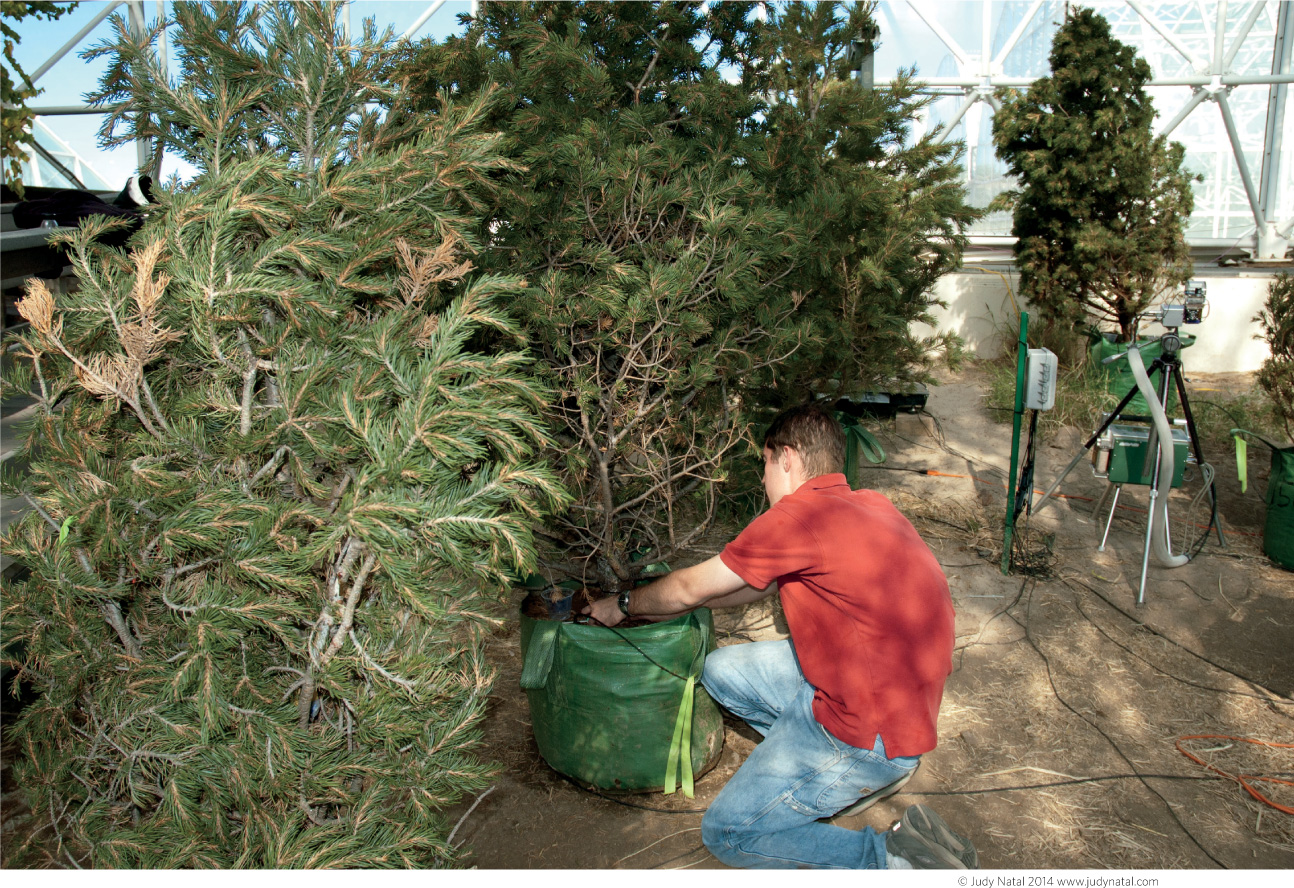Nutrients such as carbon cycle through ecosystems.
After several months under the dome, the humans grew so tired they couldn’t work. Nobody knew why, but scientists on the outside suspected that it had something to do with nutrient cycles.
On Earth, nutrients cycle through both biotic and abiotic components of an ecosystem— organisms, air, land, and water. They are stored in abiotic or biotic parts of the environment called reservoirs, or sinks, and linger in each for various lengths of time, known as residence times. Organisms acquire nutrients from the reservoir, and those nutrients are then cycled through the food chain and eventually are returned to the reservoir.
biotic
The living (organic) components of an ecosystem, such as the plants and animals and their waste (dead leaves, feces).
abiotic
The nonliving components of an ecosystem, such as rainfall and mineral composition of the soil.
reservoirs (or sinks)
Abiotic or biotic components of the environment that serve as storage places for cycling nutrients.

150
For carbon, the atmosphere—where carbon is stored as CO2 —is the most important reservoir. (Oceans and soil are also abiotic reservoirs for carbon. Oceans absorb CO2 directly from the atmosphere, and soils accumulate it during decomposition.) Plants and other photosynthesizers use carbon molecules from atmospheric CO2 to build sugar, and they release oxygen in the process. Because they “produce” sugar (an organic molecule) from inorganic atmospheric CO2, they are called producers.
producer
An organism that converts solar energy to chemical energy via photosynthesis.
This sugar molecule represents stored chemical energy that the producer can use. A consumer, the organism that eats the plant (or that eats the organism that eats the plant), also uses the chemical energy of sugar. This energy is released to the cell via the process of cellular respiration. All organisms—producers and consumers—perform cellular respiration. (For more information on producers, consumers, and the food chain, see Chapter 10.) INFOGRAPHIC 8.7
consumer
An organism that obtains energy and nutrients by feeding on another organism.
cellular respiration
The process in which all organisms break down sugar to release its energy, using oxygen and giving off CO2 as a waste product.
CARBON CYCLES VIA PHOTOSYNTHESIS AND CELLULAR RESPIRATION
In photosynthesis, producers use solar energy to combine CO2 and H2O to make sugar, releasing O2 in the process. When producers (or any consumer who eats another organism) need energy, they break apart the sugar via the reverse reaction, cellular respiration. Oxygen is required for this reaction (which is why it is called “respiration”).


Identify some producers and consumers in your own ecosystem.
Answers will vary. In a temperate deciduous forest ecosystem some producers are oak trees, Christmas ferns, algae in streams, mosses, a variety of grasses, etc. Some consumers are white-tailed deer, ground hogs, red-tailed hawks, bobcats, mushrooms, salamanders, etc.
From its initial incorporation into living tissue via photosynthesis, to its ultimate return to the atmosphere through respiration or through the burning of carbon-based fuels, carbon cycles in and out of various molecular forms and in and out of living things as it moves through the carbon cycle. INFOGRAPHIC 8.8
carbon cycle
Movement of carbon through biotic and abiotic parts of an ecosystem. Carbon cycles via photosynthesis and cellular respiration as well as in and out of other reservoirs, such as oceans, soil, rock, and atmosphere. It is also released by human actions such as the burning of fossil fuels.
THE CARBON CYCLE
Carbon cycles in and out of living things during photosynthesis and cellular respiration. As consumers (including decomposers) eat other organisms, carbon is transferred. Most of Earth’s carbon is actually stored in rocks or dissolved in the planet’s oceans, but some carbon is stored in the bodies of organisms and in soil. Without human interference, over the long term, the carbon cycle is balanced between photosynthesis and respiration.


Explain how each of these human impacts (burning fossil fuels, forest fires, and deforestation) can result in a net increase in atmospheric carbon.
Burning fossil fuels releases CO2 directly upon combustion; forest fires (anthropogenic and natural) release carbon from the trees and other organisms as they burn; deforestation reduces overall photosynthesis (fewer trees) and therefore reduces the amount of CO2 removed from the atmosphere.
Even though a single carbon atom might be captured by photosynthesis and returned to the atmosphere via cellular respiration in a few weeks or years, decades can pass before changes in a Brazilian rain forest impact a farm in Iowa. Inside Biosphere 2, the same cycle took approximately 3 days, which meant that changes in one biome could be felt in another biome much more quickly than on Earth.
Still, Biosphere 2’s carbon cycle was not that different from Earth’s; carbon moved from living tissue to the atmosphere and back in the same predictable manner. Or at least it should have. As the biospherians’ energy waned, it became clear that something had gone terribly wrong.
It turned out that oxygen levels had fallen steadily—from 21% down to 14%. At such low concentrations, the biospherians were unable to convert the food they consumed into usable energy. “We were just dragging ourselves around the place,” Poynter says. “And we had sleep apnea at night. So we’d wake up gasping for air because our blood chemistry had changed.”
In just a few months, some 7 metric tons of oxygen—enough to keep six people breathing for 6 months—had gone missing. As scientists from Columbia University later discovered, soil microbes were gobbling up all that O2 and converting it into CO2 as they decomposed the organic matter in the soil.
KEY CONCEPT 8.6
Carbon cycles through the environment via photosynthesis and cellular respiration. This cycle is becoming unbalanced due to human actions that increase the amount of atmospheric carbon dioxide.
The biospherians responded by filling all unused planting areas with morning glory vines, a pretty and fast-growing (but, as it turned out, invasive) species they hoped would maximize the amount of CO2 converted back into O2 by photosynthesis. But even with an abundance of plants and enough CO2, photosynthesis was still limited by the availability of sunlight; even the morning glories couldn’t keep up with the soil microbes in their warm, well-watered, highly organic soil.
151
Biosphere 2 is not alone with regard to a disrupted carbon cycle. Human activity has greatly altered carbon amounts in Earth’s atmosphere. Many of our actions (like burning fossil fuels) increase the amount of carbon normally released into the atmosphere or degrade natural ecosystems so that less carbon is removed from the atmosphere (as in the case of deforestation). Just as with Biosphere 2, this extra atmospheric carbon causes problems such as global climate change, acidification of oceans, and alterations of communities worldwide.
Adding to the confusion, concrete used to build parts of Biosphere 2 was absorbing some of the CO2 and converting it into calcium carbonate, trapping some of the carbon and oxygen in this unexpected sink.
Besides carbon, other chemicals essential for life, such as nitrogen and phosphorus, cycle through ecosystems. Nitrogen, the most abundant element in Earth’s atmosphere, is needed to make proteins and nucleic acids, but plants cannot utilize nitrogen in its atmospheric form (N2). All plant life, and ultimately all animal life, too, depends on microbes (bacteria) to convert atmospheric nitrogen into usable forms as part of the nitrogen cycle.
nitrogen cycle
A continuous series of natural processes by which nitrogen passes from the air to the soil, to organisms, and then returns back to the air or soil.
152
In a process called nitrogen fixation, bacteria convert atmospheric nitrogen (N2) into ammonia (NH3), which plants subsequently take up through their roots; consumers take in nitrogen via their diet. A small amount of N2 is fixed by lightning, producing nitrate (NO3). In other steps of the nitrogen cycle (decomposition, nitrification, and denitrification), various types of bacteria feed on nitrogen compounds in organic matter or the soil, eventually returning it to the atmosphere as N2. INFOGRAPHIC 8.9
nitrogen fixation
Conversion of atmospheric nitrogen into a biologically usable form, carried out by bacteria found in soil or via lightning.
THE NITROGEN CYCLE
Nitrogen, needed by all living things to make biological molecules like protein and DNA, continuously moves in and out of organisms and the atmosphere in a cycle absolutely dependent on a variety of bacteria.


Look closely at the nitrogen cycle. How many different types of microbes are needed to complete the entire cycle?
Four:
1. Nitrogen fixing bacteria are needed to convert N2 to NH3, a form of nitrogen that can be used by many producers.
2. Microbes are needed to decompose organic matter, releasing NH4 as a waste product.
3. Bacteria are needed for nitrification to convert NH4 to NO3.
4. Denitrifying bacteria are needed to convert NO3 back to atmospheric nitrogen (N2).
In Biosphere 2, the nitrogen cycle was disrupted. Thanks to an overabundance of soil microbes, nitrous oxide (N2O), or laughing gas, a normal by-product of denitrification, reached levels high enough to interfere with the metabolism of vitamin B12, which is essential to the brain and nervous system.
The phosphorous cycle was also disrupted in Biosphere 2. Unlike nitrogen and carbon, phosphorus—which is needed to make DNA and RNA—is found only in solid or liquid form on Earth, so the phosphorus cycle does not move through the atmosphere but passes from inorganic to organic form through a series of interactions with water and organisms. INFOGRAPHIC 8.10
THE PHOSPHORUS CYCLE
Phosphorus, needed by all organisms to make DNA, cycles very slowly. It has no atmospheric component but instead depends on the weathering of rock to release new supplies of phosphate (PO4) into bodies of water or the soil, where it dissolves in water and can be taken up by organisms. Microbes also play a role when they break down organic material and release the phosphate to the soil.


How might phosphorus from farms enter aquatic ecosystems (rivers, streams, lakes, and oceans)?
It can enter these water bodies by having fertilizer or animal waste wash off the surface of the ground during a rain event; it could also enter due to a spill from a storage tank or breach in a manure lagoon.
153
In Biosphere 2 phosphorus got trapped in the water system, polluting aquatic habitats, because the underwater and terrestrial plants there were dying off too quickly to complete this cycle. Biospherians removed excess nutrients from their water supply by passing the water over algal mats that would absorb the phosphorus and could then be harvested, dried, and stored.
phosphorus cycle
A series of natural processes by which the nutrient phosphorus moves from rock to soil or water, to living organisms, and back to soil.
As food reserves dwindled, the eight biospherians split into two factions. One group felt that scientific research was the top priority and wanted to import food so that they would have enough energy to continue with their experiments. The other group felt that maintaining a truly closed system—one where no biomass was allowed to enter or leave—was the project’s most important goal; proving that humans could survive exclusively on what the dome provided would be essential to one day colonizing the Moon or Mars. To them, importing food would amount to a mission failure. “It was a heartbreaking split,” Poynter says. “Just 6 months into the mission, and two people on the other side of the divide had been my closest friends going in.” Eventually, Poynter snuck in food. That wasn’t the only breach. To solve the various nutrient cycle conundrums, the project’s engineers installed a CO2 scrubber and pumped in 17,000 cubic meters (600,000 cubic feet or about 4 million gallons) of oxygen.
154

KEY CONCEPT 8.7
Nitrogen and phosphorus move through the environment in cycles that depend on physical and biological processes and are heavily dependent on a wide variety of bacteria. Human impact has unbalanced these cycles.
Biosphere officials hid these actions from all but a few key people. When one reporter finally broke the story, the public was outraged. Spectators of every ilk—seasoned scientists, skeptical reporters, and casual observers alike—became convinced that other data were also being fudged. “Secrets are like kryptonite to the scientific process,” says Griffin. “Once you find out something has been deliberately overhyped or downplayed, or just plain lied about, all the data from that research becomes suspect. And data that can’t be trusted has no scientific value.”
Three years after the first mission was completed, the editors of the respected journal Science deemed the entire project a failure. “Isolating small pieces of large biomes and juxtaposing them in an artificial enclosure changed their functioning and interactions, rather than creating a small working Earth as originally intended,” they wrote. For the $200 million dome to survive as a scientific enterprise, they concluded, it would need dramatic retooling.
Three years after the first mission was completed, the editors of the respected journal Science deemed the entire project a failure.
155